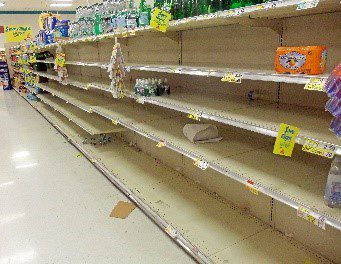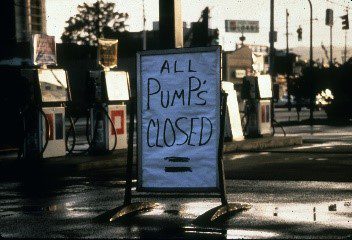 Disruption is ambiguous. Sometimes it’s good. Sometimes it’s not.
Disruption is ambiguous. Sometimes it’s good. Sometimes it’s not.
Disruptive technologies improve our health and well-being. Disruptive business models revolutionize markets, create fortunes, and drive economic growth.
Disruptive behavior sends students to the principal’s office and adults to jail. Disruptive events generate crises, create mayhem, and turn people’s worlds upside down.
 Supply Chain Disruption is always unambiguously, painfully bad.
Supply Chain Disruption is always unambiguously, painfully bad.

“Supply chain disruption” invites visualization: natural disasters, armed conflicts, pandemics, environmental incidents, trade wars, transportation failures, and cyberattacks. Supply chain disruptions are in the news almost daily, from Colonial Pipeline to JSB, from megaships lined up to enter the Suez Canal to semiconductor chip shortages. Supply chain disruptions are part of our regular personal experiences: empty store shelves, gas stations without fuel, and late Amazon deliveries.  Lurching from one supply shortage to the next, our presumption that markets function smoothly seems like a fantasy, despite the teachings of microeconomists and general equilibrium theory.
Lurching from one supply shortage to the next, our presumption that markets function smoothly seems like a fantasy, despite the teachings of microeconomists and general equilibrium theory.
Procurement Learnings for the Next Normal. Supply chain disruption has now become a widely accepted fact of life. Why were we so surprised? Supply Chain Management Review delivers a diplomatic message to a profession whose planning failed to anticipate the last year and a half:
“The procurement function stands at the precipice of a new decade, one that will be punctuated by endless macro disruptions, massive technological innovation and a new generation of professionals.”
To be blunt, it is time for an upgrade or at least a change in practice. Too many procurement professionals took too much for granted as they drove prices to rock bottom and implemented just-in-time inventory policies.
Disruption of supply chains disrupts the traditional zero-sum game that buyers play with sellers. Academics, who warned long ago of vulnerabilities in supply chain management, have been vindicated. Bloomberg Law makes the point succinctly.
“For decades, physical supply chain management has been based on low-cost supply and minimal inventory, a strategy that has benefited both the consuming public and global manufacturers. But in response to the disruptions occasioned by Covid-19, climate change, and new trade relationships, companies are reevaluating, rethinking and redesigning their supply chain strategies to increase optionality and minimize fallout from future interruptions.”
Procurement professionals, who used to concentrate on commoditizing their vendors’ offerings, now need to understand their vendors’ differentiation. Procurement departments need to shop for extra value from their suppliers, not just for the lowest price.
How Can Sellers Help? Balance is being restored to the relationship between strategic buying and strategic selling, but more collaborative conversations between buyers and sellers won’t happen automatically. Commercial organizations and their sales teams need to understand how their offerings are differentiated even if their products are not. Then they need to communicate and capture the value they deliver.
Four steps will help commercial teams improve collaboration with key customer accounts:
-
 Replay the last year. How did your team go above and beyond? Chances are, you sought to humanize customer conversations as everyone entered lockdown. The human connections we made online in the face of disruption and fear will probably stay with us for a while. Identify those moments when you helped customers in a bind. Maybe you prioritized a delivery or accommodated payment delays. Perhaps you passed on useful market intelligence or came up with ways to help customers manage risks.
Replay the last year. How did your team go above and beyond? Chances are, you sought to humanize customer conversations as everyone entered lockdown. The human connections we made online in the face of disruption and fear will probably stay with us for a while. Identify those moments when you helped customers in a bind. Maybe you prioritized a delivery or accommodated payment delays. Perhaps you passed on useful market intelligence or came up with ways to help customers manage risks.
Even if the product you were selling was a commodity, your offering was differentiated if your team went to extraordinary lengths. You behaved like a business partner or a trusted advisor, not a vendor. There was value to your customer in that. Remind them before they forget. Having a value conversation positions you for impending normality. You will be surprised at how many ways that you already are, or could be, differentiated. You might think the services you provide are table stakes, but your organization may have been an outlier. When others were running for cover, your team could have been creating differentiated value. Search for differentiation in new places and record it.
-
 Don’t run away if contracts come up. A reassessment of vendor relationships by your buyers is natural as the world returns to normal. Even if some of your contracts were hovering on the precipice of the breach, make your intentions and your efforts clear as you acknowledge delivery and supply issues. Consider subtly or explicitly communicating the extra costs you incurred to support your customers. Buyers realize that one of the most profound shortages they experienced last year was a shortage of real-time information. They are looking for a new commitment to transparency in the face of uncertainty.
Don’t run away if contracts come up. A reassessment of vendor relationships by your buyers is natural as the world returns to normal. Even if some of your contracts were hovering on the precipice of the breach, make your intentions and your efforts clear as you acknowledge delivery and supply issues. Consider subtly or explicitly communicating the extra costs you incurred to support your customers. Buyers realize that one of the most profound shortages they experienced last year was a shortage of real-time information. They are looking for a new commitment to transparency in the face of uncertainty.
Let the lawyers worry about contract enforcement and penalties. They spent the last year debating common law defenses of impossibility and impracticability. They reviewed and studied the explicit force majeure language across your contracts. Regardless of litigation and the determinations of arbitration or the courts, your legal and moral position is always best if you document your efforts to perform under a contract. Communicating issues, the steps you have taken, and the steps you will take to prevent them is helpful in dealing with the past and in revising the framework for the future.
Buyers have emerged seeking to work with viable, resilient vendors who collaborate transparently to perform on commitments and step up in troubled times. Sustainable business profitability is more valuable to buyers than protracted legal proceedings and court-imposed damages. Buyers would rather invest in flexible, differentiated vendor relationships than in expanding their legal teams.
-
 Deliver your quantified Value Proposition. Once you have identified and documented your differentiation as a vendor, proactively measure and communicate its value to your customers. In a 2014 webinar entitled “Transforming Commodity Products into Value Offerings,” George Cresman made a clear point: Whether or not your products are innovative, your differentiated, ancillary services create offerings that are valuable to your customers. Customer value is measurable. Measured value can and should be effectively communicated. Communicated value improves results.
Deliver your quantified Value Proposition. Once you have identified and documented your differentiation as a vendor, proactively measure and communicate its value to your customers. In a 2014 webinar entitled “Transforming Commodity Products into Value Offerings,” George Cresman made a clear point: Whether or not your products are innovative, your differentiated, ancillary services create offerings that are valuable to your customers. Customer value is measurable. Measured value can and should be effectively communicated. Communicated value improves results.
The quantification part of this work is not hard. Consider your differentiated customer benefits and come up with hypotheses as to what they are worth. Design a simple presentation of those hypotheses so that your sales teams can tell a simple value story. Discuss, validate, and refine your Value Proposition with your best current customers. Value Propositions are generalizable. Elements of a Value Proposition discussed and validated with one key customer can be refined, tailored, and reused with other customers. Streamline and automate those conversations with a generally useful Value Proposition. The resulting value conversations will align you and your buyers.
As we help LeveragePoint users automate their Value Propositions, we see several post-pandemic trends. The services being provided, whether sold separately or packaged together with products, are receiving greater value attention. Equally important, their value is being quantified in new ways. Before the pandemic, faster, more reliable delivery provided customer value by reducing inventories and financing costs. With 2020 in hindsight, a compelling case can be made that faster, more reliable delivery avoids lost business. This change in the conversation magnifies the importance of a vendor’s role, highlighting large losses prevented instead of small improvements in working capital costs. Preventing lost business is strategic to procurement departments. Disasters averted transcend your customers’ procurement departments, supporting conversations with your buyer’s C-suite.
 Innovate with valuable offerings. You created value. You expect to align with your customers about how you plan to create value in the future. Not everyone will pay extra for that. You may not be able to provide supply preferences to everyone. Going above and beyond probably costs you more. Create and price simple segmented offerings with different service levels. Find out who is willing to put their money where their mouths are.
Innovate with valuable offerings. You created value. You expect to align with your customers about how you plan to create value in the future. Not everyone will pay extra for that. You may not be able to provide supply preferences to everyone. Going above and beyond probably costs you more. Create and price simple segmented offerings with different service levels. Find out who is willing to put their money where their mouths are.
Prepare for price negotiations with earlier value conversations. Quantified value supports your team’s price increases. Good/ better/ best offerings prepare the ground for buyers who refuse to acknowledge your value, looking instead to squeeze you on price. Deflect their attempt to commoditize your product with differentiated service packages. The term “differentiated commodity offering” is not an oxymoron.
 Supply chain disruptions have changed your customers’ outlook. Change the conversations your sales teams have with them. Understand, quantify, and communicate your new, improved Value Proposition. Commodity products and innovative products should both form the basis of valuable offerings.
Supply chain disruptions have changed your customers’ outlook. Change the conversations your sales teams have with them. Understand, quantify, and communicate your new, improved Value Proposition. Commodity products and innovative products should both form the basis of valuable offerings.
Watch this short video to see how great organizations drive value selling: Why Value? The Fiserv Experience

